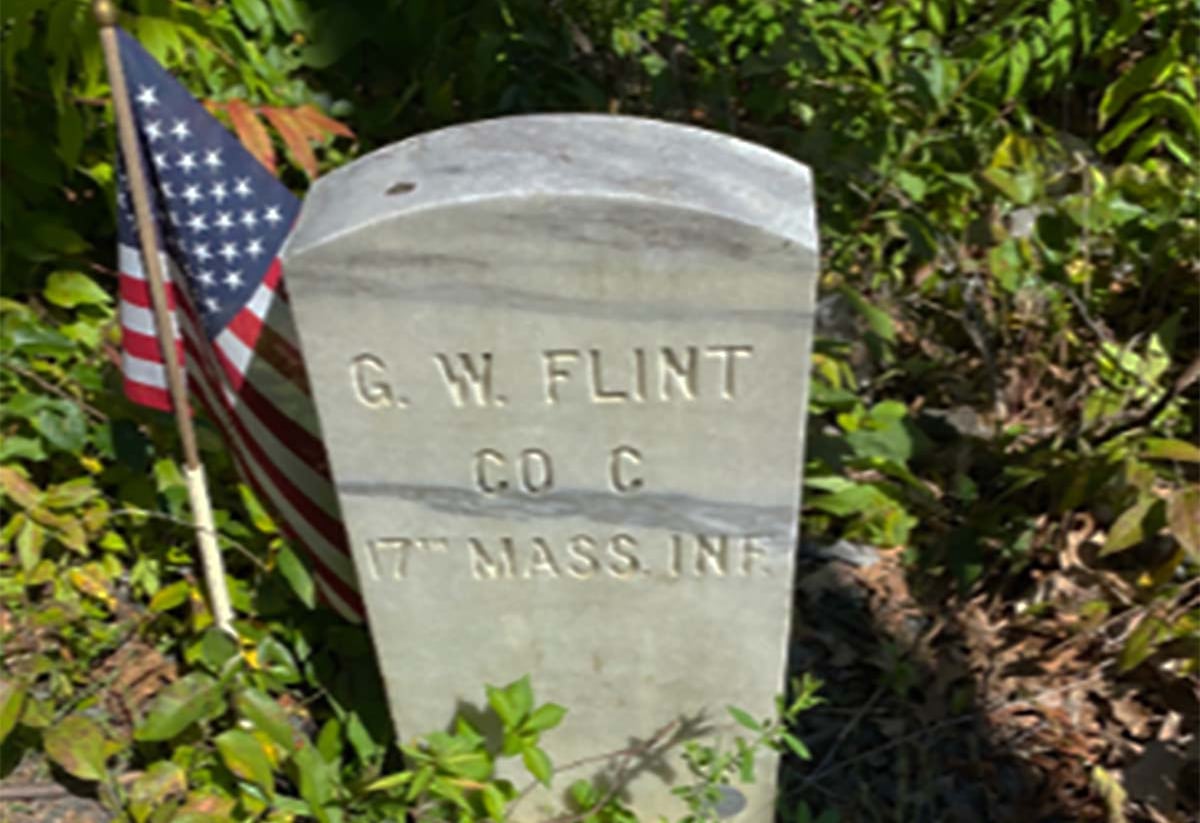
When George Washington Flint was buried in 1873, I doubt anyone suspected that in little over a century, his final resting spot would one day be the parking lot of a Dunkin’ Donuts.
Historic gravestones are a staple of New England, as is the popular chain of coffee-and-donut shops known today simply as Dunkin’. This location on Route 1 in Peabody, Massachusetts is a rare example of the two coming together. The solitary gravestone is located next to an abandoned dumpster in the grass just beyond the asphalt, and bears the following inscription: “G. W. Flint Co. C. 17th Mass Inf.”
I am by no means the first person to discover this grave. In fact, a wonderful article was written in 2012 entitled Tombstones and Donuts On Old Route 1 by Eric Schultz. Schultz was able to track down a headstone application for George W Flint and found some information about George’s family and background. He also discovered that George died in 1873, when he was in his mid-20s.
Using this information as a starting point, I wanted to learn more about the man buried in the lonely grave in the parking lot. George was born in South Danvers, Massachusetts (now called Peabody) and enlisted in the 17th Massachusetts Infantry in 1863. He was 18 years old, stood 5 feet and 8 inches tall, and was said to have black eyes, dark brown hair, and a dark complexion. His father, Warren Flint, gave George permission to enlist and signed the back of his enlistment papers. However, George would soon contract an illness and spend the majority of his service in the hospital. After his discharge, he worked as a shoemaker in the town of Natick.
The mystery began in March of 1873, when George borrowed $19 for the purpose of going to Boston to collect his pension money from his military service. What happened in the next few hours is very unclear. We know that he boarded the 5:39 evening train from Boston to Albany, and soon began to argue with the train conductor, a man named Jerome Hastings. Hastings claimed that George was fighting drunk and was quarreling with some of the other passengers. Other witnesses claimed that he was brandishing a pistol. Hastings decided to “get him off at Newton and find a constable.” It seems that after the train stopped in Newton, Hastings threw George from the train and lost sight of him.
Crucially, another witness told the Boston Globe: “The man looked and acted as one who had been drugged and no ordinary liquor could get a man in such a condition.” This witness also notes that when he was removed from the train in Newton, he “saw the man get off the train and run up the tracks.”
What happened between his exit from the train around 6:30 p.m. and 1 a.m. is a mystery. His remains were discovered by Josiah Stickney at the banks of the Charles River in Watertown. Found on his person were a Smith and Wesson pistol and his Civil War service papers. There was an inquest into his death, and the city corner ruled that he died of suffocation and exposure to the elements. Notably, there was a large injury to his head as well, but the coroner did not think it had contributed to his death.
People who knew George told the newspapers that he was not a heavy drinker, and that his habits were good. His employer at the shoemaking factory claimed that he had only suspected George of being drunk once in all of his years of knowing him.
George’s family buried him near their family home in Peabody. Days turned to months, and months turned to years. U.S. Route 1 was built, car travel became common, and a Dunkin Donuts sprung up by George’s forgotten grave. Eventually the Dunkin Donuts closed, and the site laid abandoned.
I decided to pay a visit to George’s burial place, and was happy to discover that the site is no longer abandoned. It is now the home of a barbecue restaurant called The Big Pig.
While walking the parking lot looking for George’s grave, I was approached by a puzzled but friendly employee who asked what I was looking for. When I explained, he said cheerfully, “You are looking for George!” as we approached the gravesite. He said that he often thinks about the grave, and that he and other staff members keep the marker clean and often say hi to George.
While the death of George Flint remains a mystery, his memory is being kept alive in Peabody.
Further Research
Search: Burials Databases at AmericanAncestors.org
Video Lecture: Reading the Gravestones of Early New England
Research Guide: Portable Genealogist: Cemetery and Gravestone Research
Share this:

About Jonathan Hill
Jonathan Hill is a full-time researcher at NEHGS; he earned his BFA from Lesley University in Cambridge, Massachusetts. Jonathan previously served as a board member on the Friends of the Town of Bedford Cemeteries. He has contributed to the Green-Wood Cemetery’s Civil War Project and to many other historical volunteer projects across the country.View all posts by Jonathan Hill →